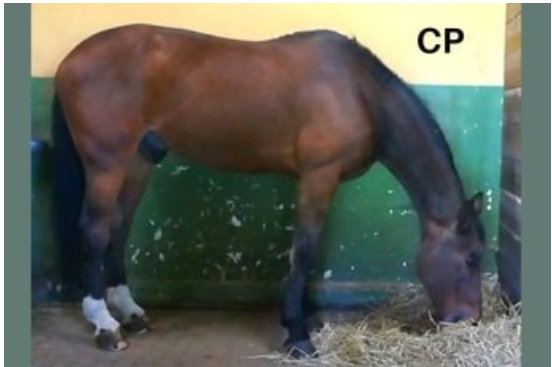Common Feeding Practices Creating Imbalances In Our Horses
- Heather U

- Mar 25, 2024
- 6 min read
The equine industry is chock-full of products marketed to help the everyday horse owner. Hay feeders, in their many forms for instance, are quite popular, as many horse people struggle to find effective ways to save hay from being wasted on the ground, or to help their horses “slow feed”, promoting gut-health and steady grazing throughout the day.
While the general concept of hay feeders is economical and practical, there are a variety of very real veterinary concerns with many of these modern-day, mass-produced equine products sold to unsuspecting horse caretakers. Unfortunately, with limited scientific studies, and education simply not catching up with consumerism, there are still many types of forage feeders being used in the horse world that are just plain harmful to our horses. In this article, I dive into the research, and the health problems that are often seen in horses utilizing slow-feed hay nets, round bale feeders, and any feeder that is elevated off of the ground. Let’s take a look.

Known Health Problems:
Horses are intended to graze with their heads down in their natural environment, and often unsuspecting horse owners are not aware that many feeders, which cause the horse to feed in an elevated position, with the head or neck raised, can cause major strain in the poll, neck muscles, jaw, and even throughout the muscles of the back. These strain injuries and negative developments within the body can come from corner feeders, hanging feeders, round bale feeders, hay nets that are hung too high, and any feeding position that will cause the horse to eat with his head and neck in an elevated position or different from the natural “head down” position.

This is because when the horse is lifting his head to feed out of man-made feeders, he is pulling back, often tilting his head or neck in an unnatural grazing position that creates tension throughout his body. This tension over time is shown to literally change the way the horse carries himself, and can even lead to a host of issues for the rider when the horse goes under saddle.
Another concern is that of the horse’s dental health. A horse’s dental health can be compromised by the position of the popular elevated feeders as the horse reaches into the feeder and his jaw is not aligned in the same way that it is when feeding from the ground in a natural grazing position. This causes the teeth to meet in a slightly unnatural position and over time may lead to sharp enamel points and uneven wear.

Photo credit: Mojave Equine Veterinary Clinic - https://mojaveriverequine.com/
Research and Clinical Observation:
Dental experts such as those at Kentucky Equine Research, the American Association of Equine Practitioners, and University of Utah Equine Extension have done deep dive observations into the impact of domestic equine feeding habits. These experts teach the importance of recognizing that how we feed our horses will ultimately impact their dental health. Feeders that are elevated, force the horse to chew in a different way from how he chews and ingests forage when his head is down, resulting in jagged edges and uneven jaws. As a result, there are concerns for how the uneven jaw can ultimately impact performance and nutrient absorption.
Photos: Raspa et al. https://www.mdpi.com/2076-2615/11/3/763/htm
A study conducted in 2021 by scientists at the University of Turin in Italy, demonstrated how the neck postures and mandibular angles differed according to horse feeding habits using a hay net hung at varying heights. This study concluded that the neck and back postures of the horse were altered when elevated hay nets were used, especially when horses were required to eat with the neck held at 15 ± 3° above the withers. The study concluded that horse muscle development can literally be altered by how the horse is required to eat. (Cited below).
In my own work as a bodyworker, I have taken notice of the differences I see in horses that are fed in a natural grazing position versus those using feeders that cause them to eat grass in a position with their heads up. I have noted significant tension in the masseter muscles, poll area, and muscles of the neck especially in these horses. I have also noticed that these horses tend to be more apprehensive to holding their heads in a lowered position given the amount of tension and discomfort they are carrying.
Research tells us that elevated head and neck positions of the horse can cause hollowing in the back as well. I have often advised my clients to use carrot stretches, pole work, and riding exercises to help improve top line muscles and abdominal strength. However, the work done to improve a horse may be completely derailed by the horse eating for hours on end in an unnatural position. These, and other interferences to how a horse would naturally live due to domestication have often proven counterproductive to our efforts in keeping our horses body sound.

Dental and muscular health have been proven to impact equine performance. It is no surprise that horses who are subjected to long durations of unnatural feeding angles may in fact struggle to perform while under saddle.
Benefits of Natural Grazing Position:
When a horse’s head is down in a natural grazing position, his muscles are more relaxed, and he chews more thoroughly, and will therefore also absorb more nutrients from the food. It is also thought that horses with their heads lowered, can avoid gastrointestinal issues associated with feeding stress, such as gastric ulcers and hindgut acidosis.
Veterinary Physiotherapist Jen Taylor notes in her research that horses that are able to graze with their heads down will avoid the strain injuries, poll tightness and reduced movement of the neck.
When a horse is eating with his head down, he is also going to be more likely to have a balanced jaw, and avoid the issues mentioned earlier with masseter muscle strain. He will reduce the risk of irritants falling into his eyes, and a lowered head promotes airway drainage, which helps flush out any dust or inhaled particles.
What Can Be Done?:
If by this point you’re throwing your hands in the air from utter disappointment after trying all sorts of feeding tactics, believe me when I say, I’ve been there. But here are some practical suggestions that have helped me with my own horse management in an effort to keep them healthy while avoiding throwing hay directly on the ground.
If you’re like me, then your horses are not in a 100% pasture grazing situation. This is quite common with domesticated horses. Not only are horse owners trying to prevent hay waste given its high cost, we are also often trying to help encourage our horses to slow down, and eat throughout the day rather than inhaling breakfast and going hours between meals. (Horses that go hours between grazing are prime candidates for gut health issues like ulcers).
I have found that getting rid of the traditional elevated feeders has significantly helped my horses. I have also tried hay nets, but quickly realized that if they are not hung low enough (close to ground), my horses do present tighter muscles in the jaw area, poll, neck and back. My equine dentist would agree that the teeth become uneven and jagged.
Horse owners can try ‘on ground’ feeding solutions that allow the horse to carry his head in a lower, natural grazing position such as full-size hay bale nets, hay pillows, hay nets that are hung near the ground, and even tire feeders. Note safety precautions: ensure hay net is not left unattended with horses that are shod as netting can become entangled on horse shoe. For tire feeders used to enclose the hay net, never use an extra-large tractor tire. Believe it or not, I have seen horses get their entire bodies stuck inside of those giant tires. Smaller truck tires can be a good option. Another option are hay feeders that are designed to mimic natural grazing, such as the box slow feeders that sit on the ground and are generally short in height. Another option is to use an old water trough like I do. I put the hay inside of the empty water tank and yes, sometimes the horses still throw the hay out, but generally I feel that it helps reduce waste. At the end of the day, I will always believe that placing hay directly on the ground is the optimal solution for my horses, but like many horse owners, trying to reduce hay waste and balance that with feeding practices that promote good health (and safety) are what I aim to achieve. The lower you can feed, the better so long as it does not compromise your horse’s safety.
Have a forage feeder idea that helps horses graze “head down” that I haven’t mentioned in this post? I’d love to hear about it. Feel free to email me.
Sources:
Raspa, F.; Roggero, A.; Palestrini, C.; Marten Canavesio, M.; Bergero, D.; Valle, E. (2021, March 10) Studying the Shape Variations of the Back, the Neck, and the Mandibular Angle of Horses Depending on Specific Feeding Postures Using Geometric Morphometrics. Animals 2021, 11, 763. https://doi.org/10.3390/ani11030763 (open access article). Retrieved from https://www.mdpi.com/2076-2615/11/3/763/htm
Jeffrey, D. (1996). Horse dentistry, the theory and practice of equine dental maintenance. Norfolk Printing Co.
Evans, J.W. (1981). Horses. San Francisco: W. H. Freeman and Company.











Comments